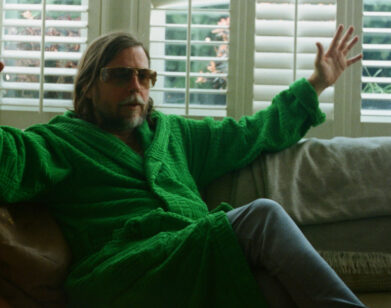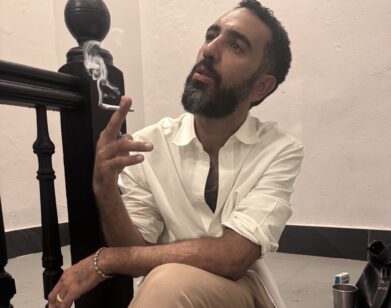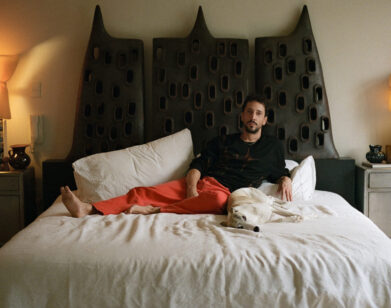The Gentlewoman’s Chanel Necklace
Photographer Roe Etheridge and artist/set-designer Andy Harman share a similar sense of humor, a similar irreverence, and more than a few credits on their résumés. Frequent collaborators, instigators, and all around bad influences on one another for years, the Florida-born Ethridge and native Ohioan Harman met in New York in 2009 and have worked together on ads for luxury brands like Céline and Chanel, as well as on editorials for Visionaire, Gentlewoman, W, and others, ever since. Their new show, “Double Bill (with Andy Harman and special guest Louise Parker),” which opened at greengrassi gallery in London on Thursday night, is a celebration of their working partnership, and a vibrant continuation of their subversive appreciation of popular culture and fetishistic consumerism. As they say, their process has become so instinctive of late they hardly even have to talk about it. Thankfully for us, they discovered they still have quite a lot to say on the topic.
ANDY HARMAN: You sound like you’re congested; I always feel like I sound like I’m Divine. But, whatever. So, this seemed like a good idea and now I’m like, “What the fuck am I going to do?”
ROE ETHRIDGE: I had an idea, which was about our struggle in Rockaway this summer.
HARMAN: Going right for the negative! [laughs] Why do you want to talk about that?
ETHRIDGE: I thought about that phenomenon we discovered, which was that we were in a sweet spot, working within the traditional parameters of an editorial, where the stylist gets a bunch of stuff, and then we take that luxury good and it gets either pushed to the edge or transformed or questioned or it gets put to a test in one way, but it also has this perverse aesthetic, fetish, finish thing that also is something that we enjoy.
HARMAN: Like the Chanel necklace [Chanel Necklace for Gentlewoman, 2014].
ETHRIDGE: We all stand around a screen and talk about the picture. I’ve often thought of it as a mercenary atelier. [laughs]
HARMAN: We had this self-imposed assignment for this show-to-prop-shop from only one place, the Key Foods in Rockaway, and just have at it, get carried away. For me it’s totally easy to get carried away with packaging, the sort of ridiculousness and beauty of it all, the similarities between artworks and the works of art on the packaging: there’s so much there, and a grocery store is just a gorgeous place. It’s seductive and lovely. It is the gem. It is the Chanel necklace. And so we pulled the necklace out, and I think what we did there is really great. But we couldn’t have done it if we didn’t have the parameters set up, like you’re saying, if we didn’t have the limits to bounce off of. I have this thing that pop culture isn’t so much about trying to usurp the luxury good; it is on the same level. They both have the same attraction to me. It’s not a negative thing.
ETHRIDGE: This brings up another phenomenon for me, which is that I sometimes need to sit for a minute—it happens all the time with images that sit in the flat file for years, and then you go, “Oh my god, why did I not use this three years ago?” It has to time-release and settle in or something. That’s already happened with the Rockaway picture of the peas and pickles [Model Prints on Pickles and Roe, 2014]—the first one that we did with the pickle background, and you see under the table a little bit.
HARMAN: It was more of a still life.
ETHRIDGE: It’s one of the early ones, so we hadn’t quite established the language yet. It wasn’t a chance situation, but in some ways it was more intuitive, even though we’re working willfully and consciously, because there was no routine established yet.
HARMAN: We had done the Céline handbag ads [a special project that run in Europe, summer 2014], which were beautiful, and fun, and the Alexis Bittar things [fall 2014], where I was totally hungover, and we just sort of went at it and it was really exciting. I’m, like, shaking and sweating all over the jewels. I felt like we were moving at such a breakneck speed, and everything was so random. We weren’t overthinking it because we just couldn’t. And I feel like we pushed passed something there, into some other realm.
ETHRIDGE: They got into that place where…”effortless” isn’t the word, because it takes effort, but I love it when I can shoot one frame of something and be like, “Got it,” and know that, whether I’m out of my mind thinking got it or not, it doesn’t matter, because you feel it.
HARMAN: Yeah, the adrenaline.
ETHRIDGE: It’s like you’re on a different, like, mental levels. It’s like peyote. [laughs]
HARMAN: How many set-ups did we do that day? Like 50?
ETHRIDGE: 60?
HARMAN: Unbelievable. Coming off of that there are not enough drugs in the world to make Rockaway pull you into that. We both felt anti-climatic a little bit, maybe. Like, it’s cool, but, “Is it different? Is it pushing?” When we were doing those, it felt like it fit into another box. It needed to go into the art world, because that was a predetermined ending, which is always complicated. It’s like a whole other set of variables.
ETHRIDGE: Like, “What are we going to transgress?” You look at your friends and peers like, “What are we doing? How do you take something that’s this traditional, in a way, and, without losing yourself to the rat race of transgression, make something happen with art?” And that thought, in and of itself, if it happens, well, then you’re not making art. If that’s what you’re doing, chasing shit around and trying to take a dump on the still life set, that sounds like Jackass. That’s fine if it’s Jackass, but I don’t know if it’s art.
HARMAN: At this point all bets are off.
ETHRIDGE: Well, what isn’t art, you know?
HARMAN: I guess it comes down to trusting your instincts and knowing that that wasn’t enough, and having enough experience under your belt to say, “It’s got to be more.” Why shouldn’t commercial photography be more? What’s interesting about the trajectory of your career is that, at one point, it felt like doing commercial stuff and bringing it into the gallery was a gesture. But it may just turn out that you’re bringing both things up.
ETHRIDGE: In my bolder moments, probably my younger years, I did think that that was what my charge was. What I was supposed to do was improve the photo aesthetics of that commercial world. I wasn’t really sure what I was supposed to do until I stopped doing project-based work, where it was like, “No, this is my art project and I’m keeping it locked, it has to have an idea and a thesis.” It was that school training thing. I never went to grad school, so I never got the full [education]. I mean, once I finished the last project that I did I was so bored. And at the same time I was doing these beauty shots for Allure [for an issue in 1999], and I had never done beauty shots before, so I had to look up how to do it. It’s kind of like when you made the turkey [for the photograph Thanksgiving 1984, 2009, taken originally for Visionaire, now in the collection at MoMA].
HARMAN: [laughs] Oh my god, yeah. Was that our first shoot? No, it was our second one.
ETHRIDGE: Was the first one that cuckoo shoot?
HARMAN: Yes, where we were putting fucking balloons and pantyhose and Italian belts around toilet paper rolls, which, in reflection, I’ve been thinking a lot about it lately, it’s really genius [for an editorial in AnOther Magazine].
ETHRIDGE: That’s one that needs to come out. I don’t know if it’s on this old laptop here. There’s a layout somewhere in my digital garbage where I have to find. We went so nuts, we started stitching…The day before the shoot it went from an eight page story to an eight page story with 60 pictures in it. Instead of having them, like, adjoined, we took a really low res detail shot of a Kleenex logo and made exes so there would be stiches between the pictures.
HARMAN: Oh, I never saw that. That sounds amazing.
ETHRIDGE: That Allure shoot was in ’99. I was like, [sighs], and my friend saw the Polaroid, and he was like, “That’s just a great picture.” I was like, “Yeah, but I can’t use it because it’s for this magazine.” He’s like, “But it’s a great picture.” So I had that feeling. I was waiting at the door, just waiting for someone to crack it open a little bit, and at that point it was like…
HARMAN: “Fuck it.”
ETHRIDGE: [laughs] Yeah, I still struggled with the notion of doing that, and I still do.
HARMAN: Well, it’s difficult, because we were schooled differently. But, we are so fucking inundated with images now. I’ve been calling it a “pomo-sexual” world out there.
ETHRIDGE: Pomo-sexual.
HARMAN: Pomo-sexual, honey. What was up is down and what’s down is up. I don’t know what to tell you, it’s just all over the place. And, it’s not that we’re fucking old, but we’re more mature in a way that we can accept certain things about pictures, about what we’re looking at, and realize that a good picture’s a good picture, and leave it at that.
ETHRIDGE: It goes further than that, because there are good pictures, there are great pictures. And I can’t tell if it’s cynical and bitter or if it’s celebrating something, but the last thing I want is cynical and bitter. I was cynical and celebrating, at the same time.
HARMAN: That’s one of the things I love about when we work together, because there’s definitely an inherent love of what Marie Chaix [a fashion stylist with whom Ethridge and Hartman often work] calls our SkyMall taste.
ETHRIDGE: SkyMall!
HARMAN: We love the SkyMall. It’s really amazing and interesting, and it says a lot about our culture, the SkyMall catalog. But at the same time we’re critical of it because it’s marketed towards us in a way. And that’s what I love about our approaches on the commercial shoots, it’s very open. “Bob’s your mom,” or whatever the hell you say there.
ETHRIDGE: Bob’s your uncle?
HARMAN: [laughs] But there’s a certain openness and freeness to our work together. I could show up with a big fake tree with googly eyes that light up and that somehow we won’t be afraid of it. We’ll look at it and riff off of it.
ETHRIDGE: It is not following a script, and, as funny as it seems, there’s usually no inside joke. But having fun. I mean, sometimes it is like, “Fuck, this mallet sucks.” [laughs] “This 50-pound, oversized mallet is a pain in my ass.” But you work with it just like any other thing that you would work with. Like the chiffon in the background isn’t blowing quite right, well, she’s not holding that mallet quite right. Asking these questions and doing it in the mercenary style–it’s amazing to be able to do that. I keep thinking of the confetti picture for some reason. [Harman laughs] I went back through in the Harlequin one and it’s like she’s making a face that… And there’s that most real cut through that balloon… [in a recent fashion editorial in which they photographed a heavily made-up model through balloons, with a giant clown-sized mallet].
HARMAN: She’s going to pop that fucking balloon. Give you her best Alice Cooper.
ETHRIDGE: But I didn’t even notice it when we were looking through it on set. I got distracted by that thing of the balloon framing.
HARMAN: Yeah, the balloon framing. Balloon framing can be a real bitch.
“DOUBLE BILL (WITH ANDY HARMAN AND SPECIAL GUEST LOUISE PARKER)” IS ON VIEW NOW THROUGH FEBRUARY 28 AT GREENGRASSI IN LONDON.







